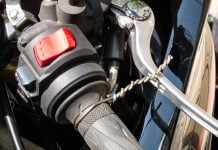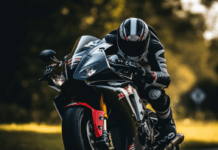Greetings fellow bikers, or as I like to call us, ‘the thrill-seekers on two wheels.’ Braking, I believe, is like an unsung hero of motorcycle riding skills. A well-timed brake can be the difference between a comfortable stop and a close call. As an experienced rider, I’ve learned that understanding your bike’s braking system is as essential as knowing how to accelerate. In this guide, I share the secrets of mastering the art of motorcycle braking.
Understanding the Braking System: Front and Rear
Every motorcycle has two brakes: the front and the rear. Typically, the front brake is controlled by the right hand lever, and the rear brake is operated by the right foot pedal. But what’s the big deal, you ask? The deal is in the distribution—about 70-90% of your stopping power comes from the front brake.
The reason is physics. As you apply the brakes, your bike’s weight shifts forward, loading the front tire and giving it more grip. It’s this grip that helps you stop effectively and safely. But remember, while the front brake provides most of the stopping power, using it in harmony with the rear brake ensures better stability and control.
Smooth Operator: The Technique of Gradual Braking
Braking is more than just a squeeze or stomp—it’s an art. A sudden grab of the brake lever can lead to a skid, or worse, a flip. So, always remember, when it comes to braking, smooth and gradual is the way to go.
- Start with a Squeeze: Apply the front brake lever with a firm, progressive squeeze. Imagine you’re squeezing an orange—you don’t crush it; you gradually apply pressure.
- Feel the Weight Shift: As you apply the front brake, you’ll feel your bike’s weight shift forward. This is when you can apply a bit more pressure on the brake lever.
- Coordinate with the Rear: As you squeeze the front brake, gently press down on the rear brake. The rear brake is excellent for stabilizing the bike, especially during low-speed maneuvers.
Remember, practice makes perfect. Spend time practicing this in a safe, open space before hitting the roads or trails.
Braking in Corners: The Advanced Lesson
One of the trickier aspects of braking is when you’re in a corner. Your tires are already working hard to keep you in the turn, and adding braking to the mix can be risky. If possible, always aim to do your braking before entering the corner. However, if you need to brake mid-corner:
- Straighten Up: Try to get your bike as upright as possible. The more vertical the bike, the more braking power you have available.
- Brake Smoothly: Use both brakes, but be gentle and gradual. Abrupt braking mid-corner can unsettle the bike and cause a loss of traction.
- Look and Lean: Look where you want to go and lean your body into the turn. Your body position can help the bike maintain balance and direction.
There you have it—the essential techniques for motorcycle braking. Remember, knowing how to stop is just as important as knowing how to go. Like any skill, it takes practice, so don’t rush it.
Brake smooth, ride safe, and keep the rubber side down, my fellow thrill-seekers!



































